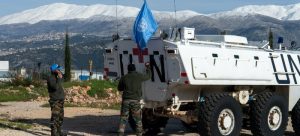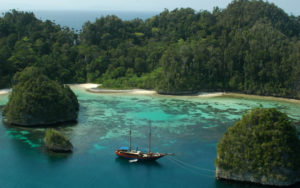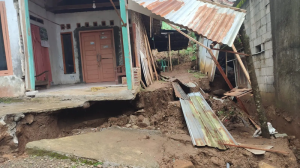
Lake Toba, North Sumatra, World’s Largest Caldera Lake & the Site of the Toba Supervolcano that created the Ice Age. It is “the largest lake in Indonesia and the largest volcanic lake in the world.” Photo #25 by Desktop Nexus.
Washington, MINA – About 74,000 years ago, a colossal volcano in Sumatra named Toba blew its top in the largest eruption to occur anywhere on Earth in the past 2 million years. Gas and ashes spewed into the atmosphere spread around the world within weeks, and some scientists think they triggered a global “volcanic winter” that may have lasted decades, leading to massive die-offs and the near-extinction of the human species.
But others have suggested that the eruption’s effects were less dramatic.
Now, subtle traces of volcanic ash at Pinnacle Point, a famous archaeological site on the southern coast of South Africa, suggest that at least some groups of early humans survived, and even thrived, in the eruption’s aftermath. The discovery also offers archaeologists an astonishingly precise time marker for dating sites around the globe, Science Magazine reported Monday.
When Toba erupted, modern humans had already traveled out of Africa to at least the Middle East and perhaps beyond. Some researchers have proposed that Toba’s eruption was big enough to cause a reverse greenhouse effect that cooled Earth for decades, leading to ecological disaster and widespread food shortages that only a few small communities were able to survive.
Also Read: Report Exposes Canada’s Role as ‘Weapons Transit Corridor’ for Israel
Volcanoes spew sulfur dioxide into the atmosphere, which can form aerosols that reflect the sun’s rays. But the theory is hotly debated. Sediments from Lake Malawi, in eastern Africa, for example, don’t show evidence for a dramatic change in plant life around the time of the eruption.
Archaeologists wanted to see whether they could find evidence for effects of the volcano at Pinnacle Point, a series of caves where archaeologists have uncovered a rich trove of bones, tools, and weapons left by Stone Age humans, some dating from nearly 200,000 years ago. They also studied Vleesbaai, an open-air site 9 kilometers away where researchers have found more Stone Age tools and animal bones.
The scientists took samples from every centimeter of sediment in a 1.5-meter vertical section of the Vleesbaai dig and also analyzed samples from key layers at Pinnacle Point. At both sites, they found a sparse sprinkling of cryptotephra, microscopic particles of glassy volcanic rock.
The chemical signatures of these fragments matched Toba ash found in Malaysia and Lake Malawi. “That’s a ‘holy shit!’ result,” says archaeologist and lead author Curtis Marean of Arizona State University in Tempe, because the ash layer marks the same date—within a month—across the entire globe.
Also Read: Trump Designates Saudi Arabia as Major Non-NATO Ally in Historic Defense Pact
Other dating techniques have about a 10% error rate, so a deposit dated as 74,000 years old could be anywhere between 66,000 and 81,000 years. Thus, the work offers a new way to correlate far-flung sites very precisely.
At Pinnacle Point, artifacts found just below and directly above the traces of ash show no gap in human use of the site, Marean and his colleagues report today in Nature.
In fact, they say, the traces of human occupation intensify shortly after the volcano’s eruption, suggesting that humans living there did just fine, Marean says.
The Pinnacle Point people are known to have eaten shellfish and other marine resources, and he speculates that the ocean may have been buffered from the volcano’s effect. “Hunter-gatherer economies are really resilient,” Marean says. “The impact on them is probably a lot less” than on flora and fauna.
Also Read: Saudi Arabia to Boost US Investments to $1 Trillion: Crown Prince
But archaeologist Stanley Ambrose of the University of Illinois in Urbana, who proposed the idea that Toba’s eruption wiped out most early humans, isn’t convinced.
Sign of dramatic environmental change
Marean’s team found sandy layers just above the ash traces, which Ambrose says are indeed a sign of dramatic environmental change and a decrease in human occupation.
Marean counters that those layers were part of a series of sand dunes that formed in a matter of days or weeks after the eruption and include human artifacts. “So no evidence for abandonment,” he says. Looking for volcanic traces at other sites could help settle the debate, he says.
Other researchers are impressed with the method’s potential, in part because they were able to isolate rare particles of cryptotephra, down to two particles per gram of sediment. “It’s a beautiful marker,” says Michael Petraglia, an archaeologist at the Max Planck Institute for the Science of Human History in Jena, Germany.
It’s especially impressive that the team was able to find ash traces 9000 kilometers from the volcano, he says. He and his colleagues hope to use similar techniques at sites in East Africa and Arabia, he says. “When you find it, it’s fantastic.” (T/RS5/RS1)
Mi’raj Islamic News Agency (MINA)
Also Read: Indonesia’s Hajj Ministry Engages Local MSMEs to Strengthen Catering for 2026 Pilgrims





























 Mina Indonesia
Mina Indonesia Mina Arabic
Mina Arabic